Cartagena without Tramp
We stayed in a very good $40 hotel on our last night in Panama which was also our last night in Central America. The hotel offered a bit of luxury we didn’t have in Tramp but we worried about him sitting on a wharf down in the port of Colon waiting to be moved onto a tray and lifted by crane onto our ship the Vega Zeta. From there he would hopefully be carried safely to Cartagena, Colombia in South America. We did it the easy way with a flight on an airline called Wingo that took only about an hour. Cartagena, here we come!
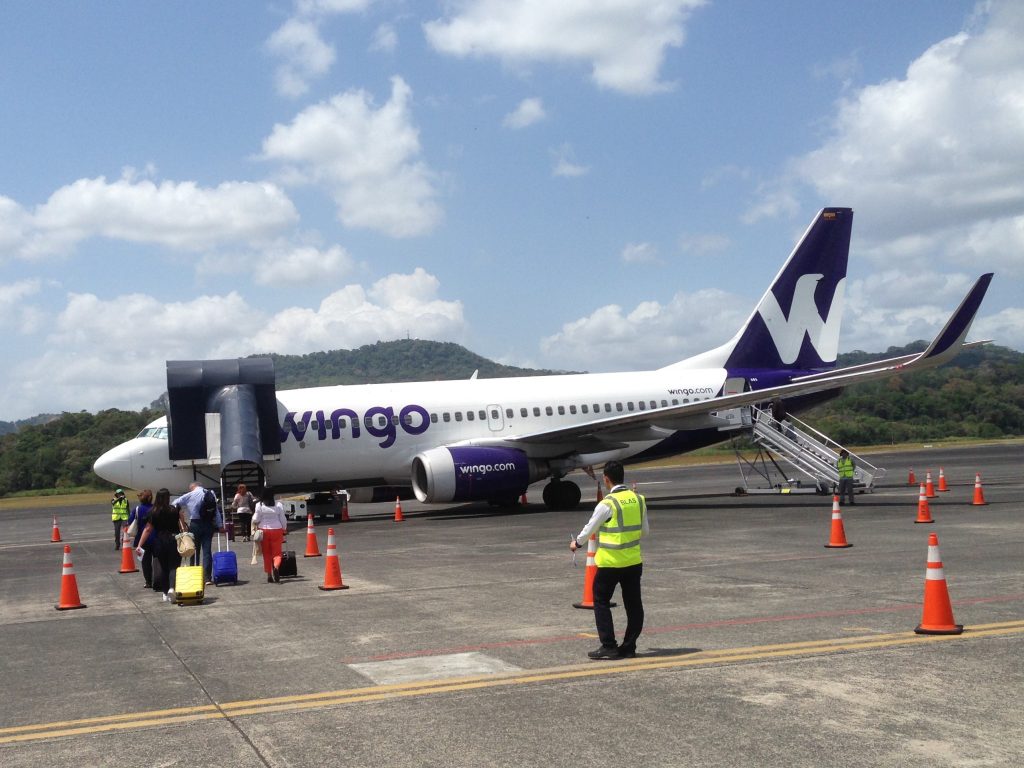
The Colombian-based low cost carrier Wingo was our weak alternative to Tramp for passing from Central America to South America
Ever since I saw the 1984 movie Romancing the Stone I have wanted to come to Cartagena. First of all, Cartagena has a cool name, which is important. The thick walls that were built to defend the city from raiding pirates are still almost completely intact and there is also a grimmer history of slave trading. But mostly it was the movie which highlighted the city’s best features and made it look like a fun, exciting and adventurous place.
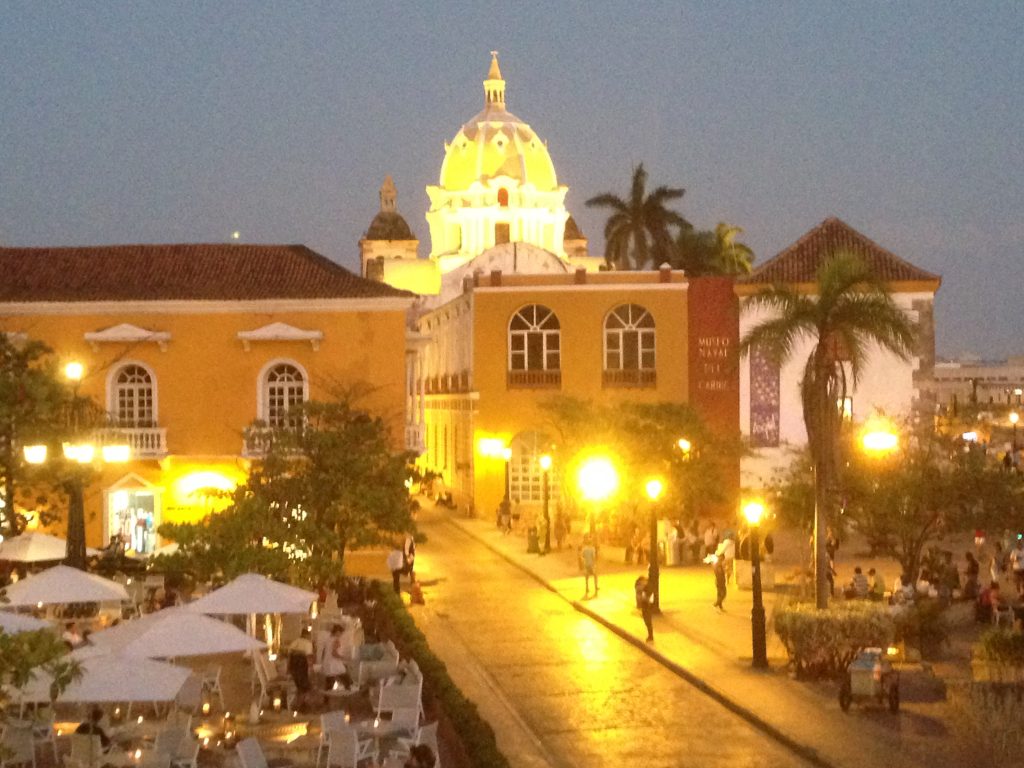
Cartagena is good by day but it was beautiful at night with all the old buildings and city walls illuminated
But Colombia hasn’t always been a place that tourists flock to. From the 1970’s to 1990’s Colombia produced about 80% of the world’s cocaine and was a world capital for drug cartels, violence, crime and corruption. But the authorities eventually got the upper hand in their war on drugs, cartel leaders were flushed out and better government has made Colombia safer while helping it rebound from its recent troughs.
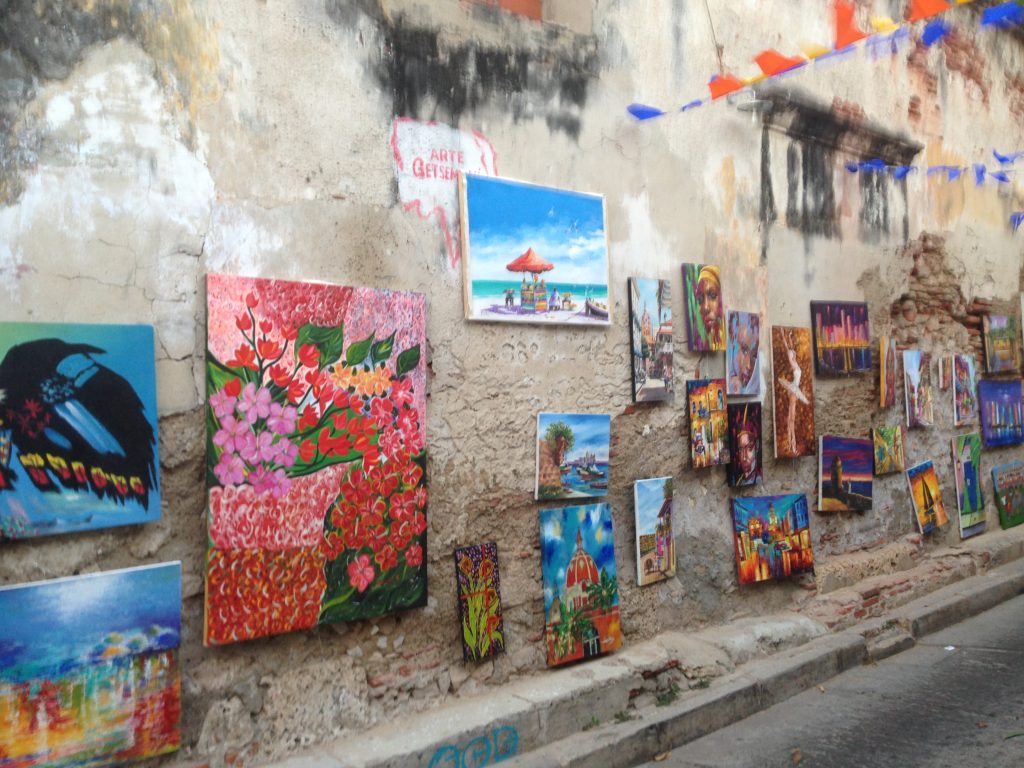
A fascinating feature of Cartagena is the street art which added colour and character to many of the old narrow streets
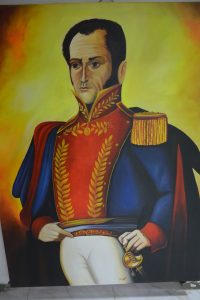
We stayed at the Simon Bolivar Hotel which was fitting since he famously liberated Colombia in the 1830’s
We chose a hotel within the old city’s ancient walls and spent a delightful afternoon exploring the narrow streets, old architecture and fascinating history of Colombia’s number one tourist attraction. The buildings within the walls, most of them at least partly original from the 16th or 17th century, featured high ceilings, balconies dripping with colourful flowers and lively shops selling mostly upmarket items and tourist souvenirs. The churches were magnificent examples of Spanish architecture and the plazas were lively with colour and movement. Cartagena has romance, culture and class.
The next day we opted for the hop-on hop-off open double decker bus tour, similar to the one we enjoyed in Havana, and it gave us a broader look of not just the historic old town but also the San Felipe Castle, the nearby beaches and the prosperous high-rise areas of Bocagrande and La Laguito.
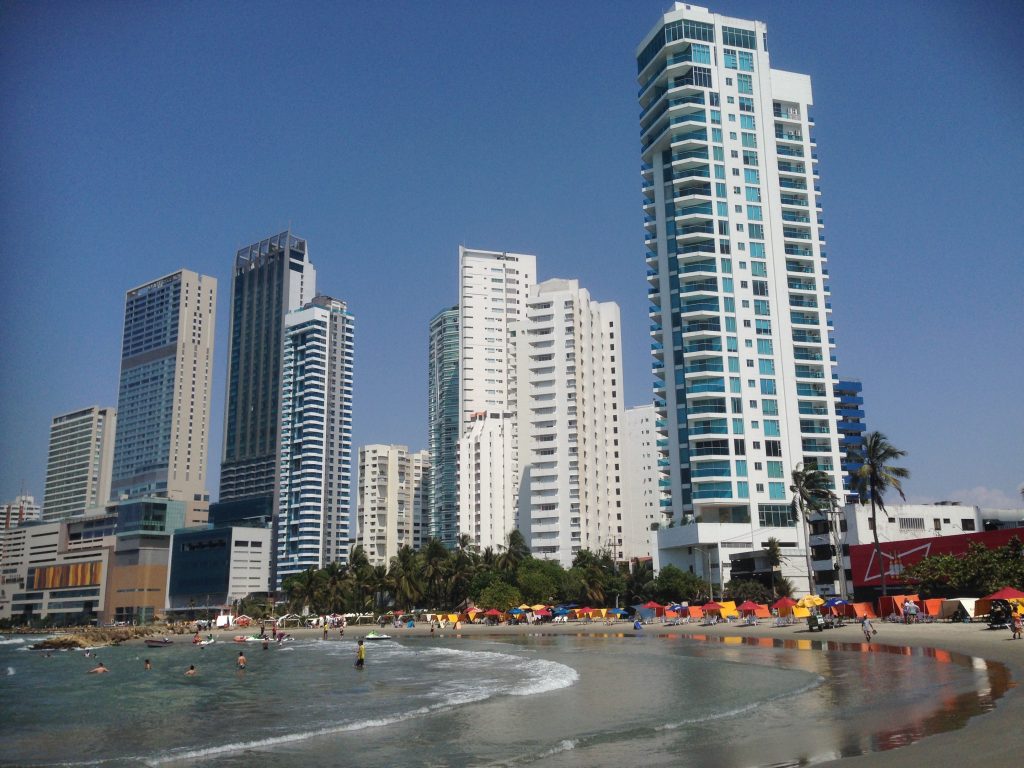
Bocagrande, one of the new parts of Cartagena, looked like any popular beach city – glittering high rises, long sandy beaches and plenty of people enjoying the scene
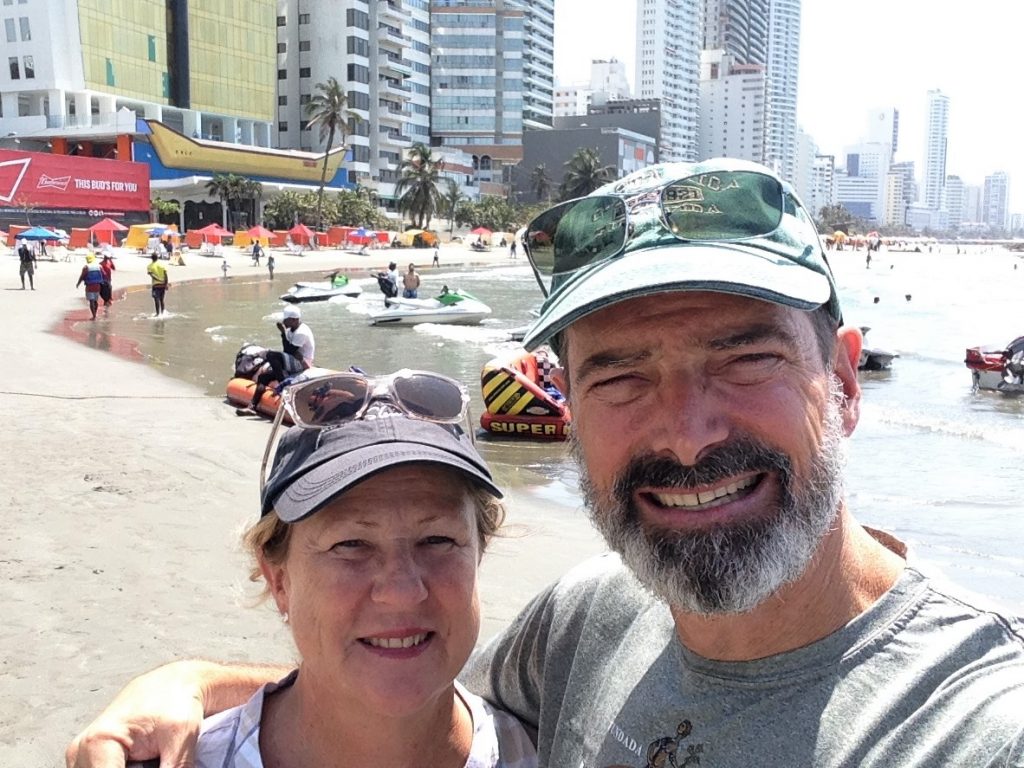
Most of the beaches near Cartagena were ‘private’ which meant that in theory they were used only by nearby hotel guests – not many locals come here
But the old city is where it’s really happening in Cartagena. Founded in 1533, the Spanish used the city as a transit point for all the gold , silver and other riches it extracted from the land and the indigenous people before shipping it back to Europe. As a result it was a favourite target of pirates in the 16th century, including the legendary Francis Drake. In response the Spanish built elaborate thick walls encircling the town and a series of forts that protected the city from subsequent attacks and sieges.
We took a walking tour of the old city which highlighted the dreadful trading in slaves from Africa and the impact on the town’s citizens from what is now known as the Spanish Inquisition which severely punished a range of bad people, including Jews, witches, Calvinists, blasphemers and other troublemakers. The colonial churches have retained all their charm and the many plazas that are scattered within the walls provide shade, sanctuary and a place to rest from the obscene heat.
We also finally solved one of our biggest dilemmas. After a search of many cities over the last couple of weeks we finally found an outdated Lonely Planet guidebook for South America. It may be 15 years old, faded, battered and water damaged but it will still meet our needs for the next leg of our journey. We have other books for specific countries like Peru, Argentina and Chile but we were lacking an overall book that helps us in other areas.
We had a delightful evening sitting at a small outdoor table of a café on the Plaza de la Trinidad where for a couple of hours we watched street performers and all the passersby while enjoying drinks and dinner. The evening reinforced what a special place Cartagena is, full of character and personality.
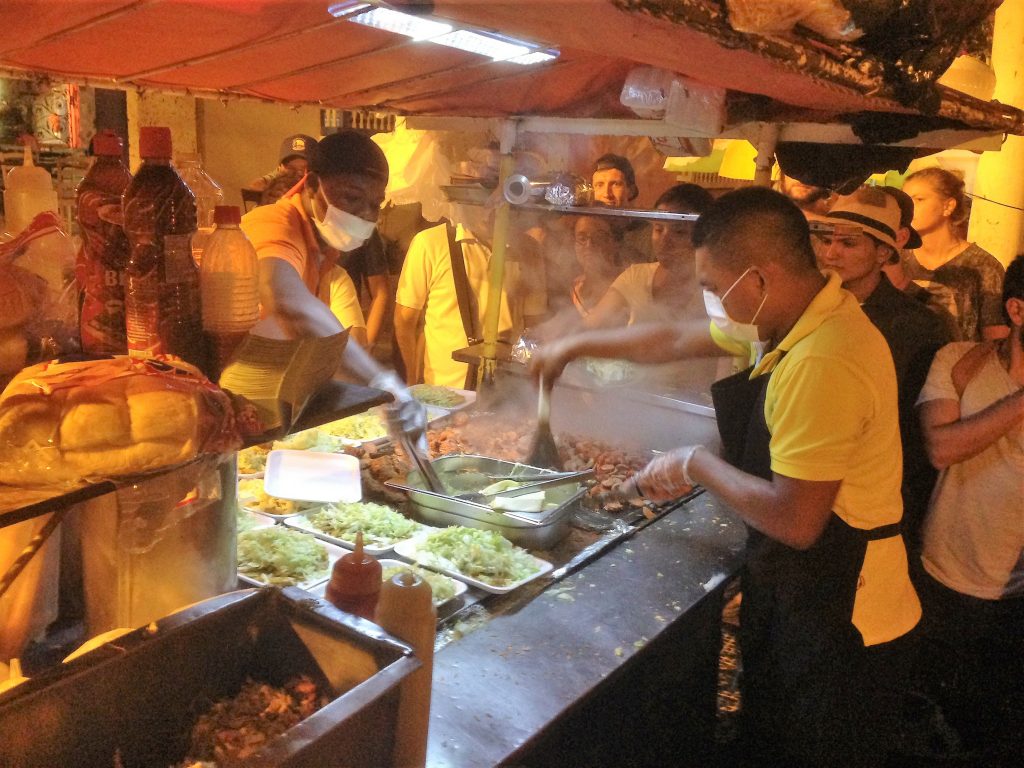
One option for dinner at Plaza de la Trinidad are these street vendors but you have to be prepared to stand in a queue!
But a day of walking and exploring the streets of Cartagena is largely dictated by the heat so the next day we rose early and walked to the Castillo San Felipe, the magnificent castle sitting on the hill above the old town. The Spanish built this castle to help defend the city from attacks by land and over a 300 year period the city and the fort came under frequent attack and was seized by pirates and various foreign forces.
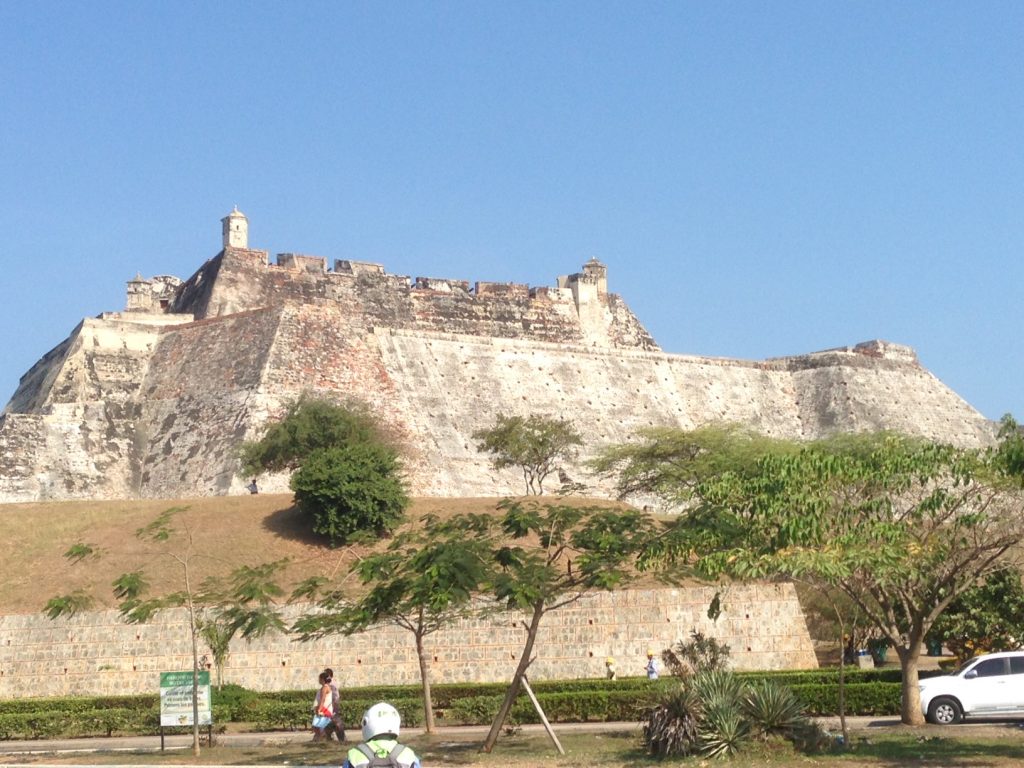
Castillo San Felipe, sitting proudly on the hill outside of Cartagena, played a major part in defending the walled city
The largest Spanish-made structure in the Americas, the castle is well preserved, features magnificent views over the old and new part of the city and has an extensive network of tunnels that weave their way under the castle complex. These tunnels are not for the claustrophobic, they are low and narrow, very hot and stuffy, sometimes steep and quite dank. Never mind, it was good to explore them before the crowds arrived.
We wandered through more of the old town, just couldn’t get enough of it, and that afternoon headed to a fashionable bar on the city’s walls to take in the cool ocean breezes and watch the sun set on the ocean. This was where all the beautiful people hung out, weekenders from Bogota and other places in Colombia, mostly young, all very fashionable. This was a scene we rarely if never saw in Central America and we enjoyed the people watching.
That night we had dinner in one of the beautiful plazas of the old city with the 17th century Spanish church illuminated in all its glory while hosting a wedding. Musicians, street performers, hawkers trying to sell you cold water, hats, sunglasses, macarenas, jewellery and even roasted ants (please! I’m eating dinner!) were a constant form of entertainment or annoyance. Horse drawn carriages rumbled across the cobblestone streets and the whole scene was just magical.
Travel is all about new experiences, that’s for sure, but an extended trip like ours also has a hidden aspect which includes all the planning, financial stuff, administration and boring paperwork that goes along with it. We also have to stay on top of all the issues in Australia, including our tenants, bills to pay, taxes, friends and family, the list goes on and on.
So on Sunday in Cartagena we allowed ourselves a rare luxury – a day almost completely devoted to catching up on all the paper and admin work that we had fallen behind on. The two big issues are preparing for the bureaucratic nonsense that is involved in getting Tramp off the Vega Zeta and secondly, to begin the planning of our journey around South America. Planning our time in South America is complicated by a number of important factors but the bottom line is our time is tight and we can’t just aimlessly wander around the continent. Damn it!
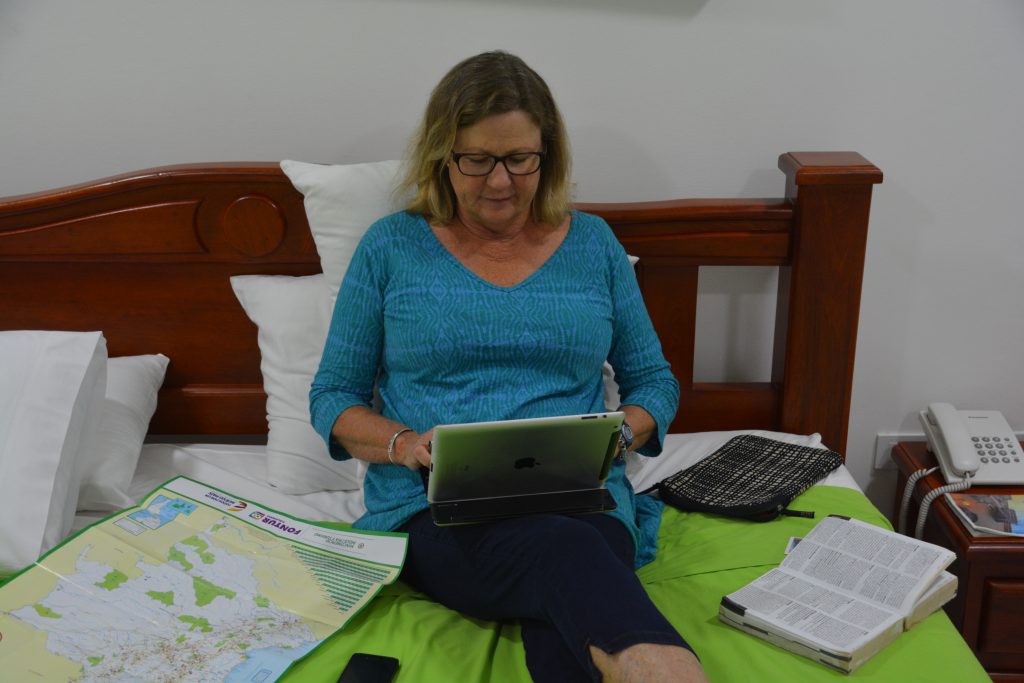
Julie does most of the research on where we want to go next and planned our trip to the Galapagos from our hotel in Cartagena
The following day we were down at the shipping container port in Cartagena to begin the long process of extracting Tramp from Customs. Bad news, the lady said, the Vega Zeta is still at sea, delayed for reasons unknown, and won’t be in port until manana. So somewhat glumly we turned around, jumped in another cab and headed back to our hotel.
Hotel Simon Bolivar, our home now for almost a week, took pity on us and gave us a larger and quieter room for the next two nights. We indulged in their pool, swore at their wifi and had lunch in a new part of town. Luckily we enjoy Cartagena because we’re really getting to know it.
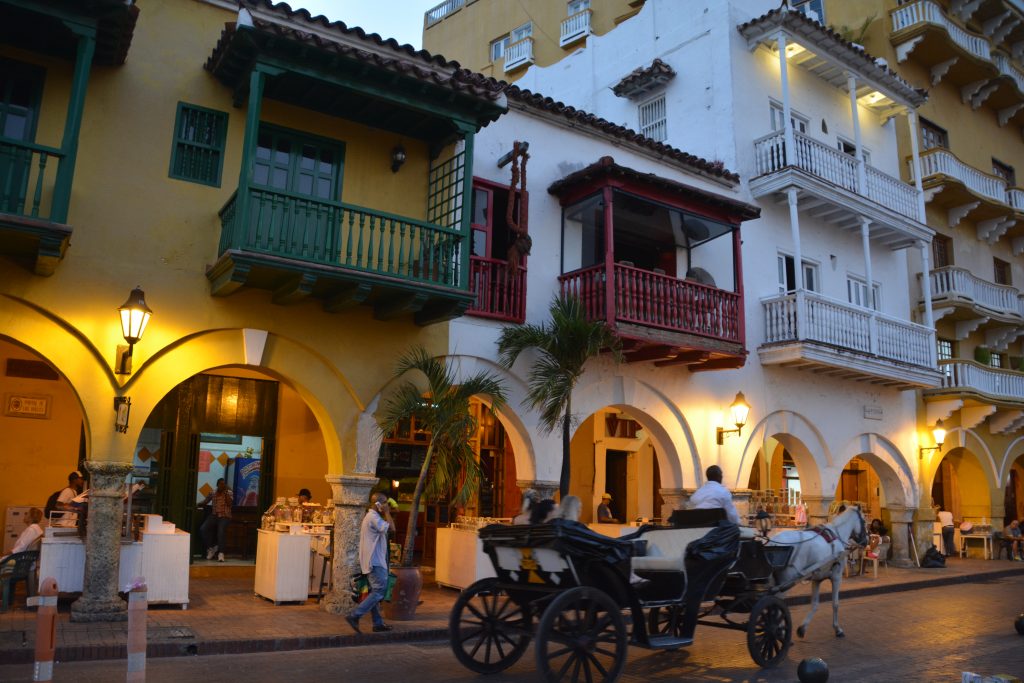
The evenings in Cartagena were just magic and we found one bar on a street corner that gave us a perfect vantage point for all the local traffic
Back at the shipping company’s office the next day we learned the truth of our ship – it was delayed by about five days due to mechanical problems. Including weekends it appeared we would end up spending another week in Cartagena. This was devastating news for many reasons – the huge cost, inconvenience and frustration, more worry about Tramp but worst of all was the lost time. To lose a week on our relatively tight timeframe was an absolute killer.

We started to get a bit weary of the heavy Colombian food which was dominated by grilled meat, rice and beans so we went wild with pizza one night
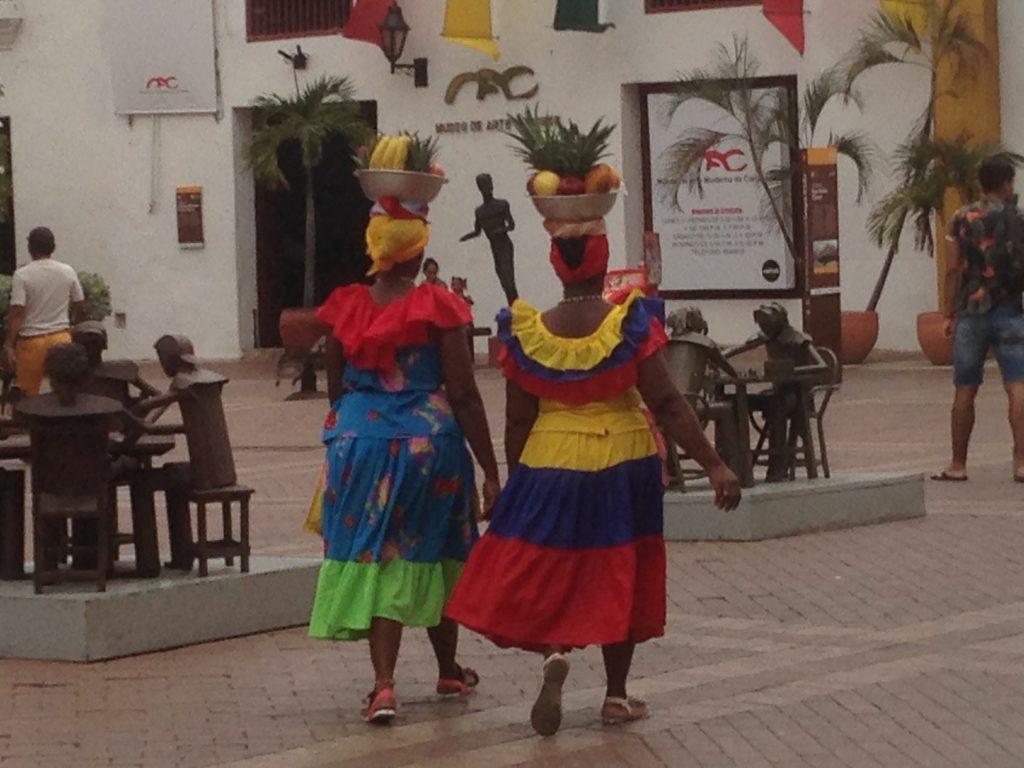
Another form of colour – these ladies were looking for tourists but added a very Colombian-Caribbean flavour to the old town
One of the key attractions near Cartagena is the beautiful set of islands off the coast that make up Isla Rosario National Park. Julie and I forked out for a day trip to the islands and enjoyed a day watching how Colombians play in their own backyard. The ocean was choppy and our little boat bounced its way across the water as we stopped at many islands to allow locals to get on and off. We also stopped at the so-called Oceanaria, like a poor man’s ocean aquarium way out on a small island, but decided to opt out of the entrance fees.
Eventually we ended up at Playa Blanca, the only public beach on the islands, a long white sandy strip of beach that was a perfect setting for thousands of Colombians to strip down and jump in. We had lunch in one of the open palapas (thatched shade houses) and a swim in the surf while avoiding having to pay outrageous fees from all the hawkers for chairs, lounges or umbrellas that lined the beach. Overall a very enjoyable way to mix with the locals and take in some sun and sand.
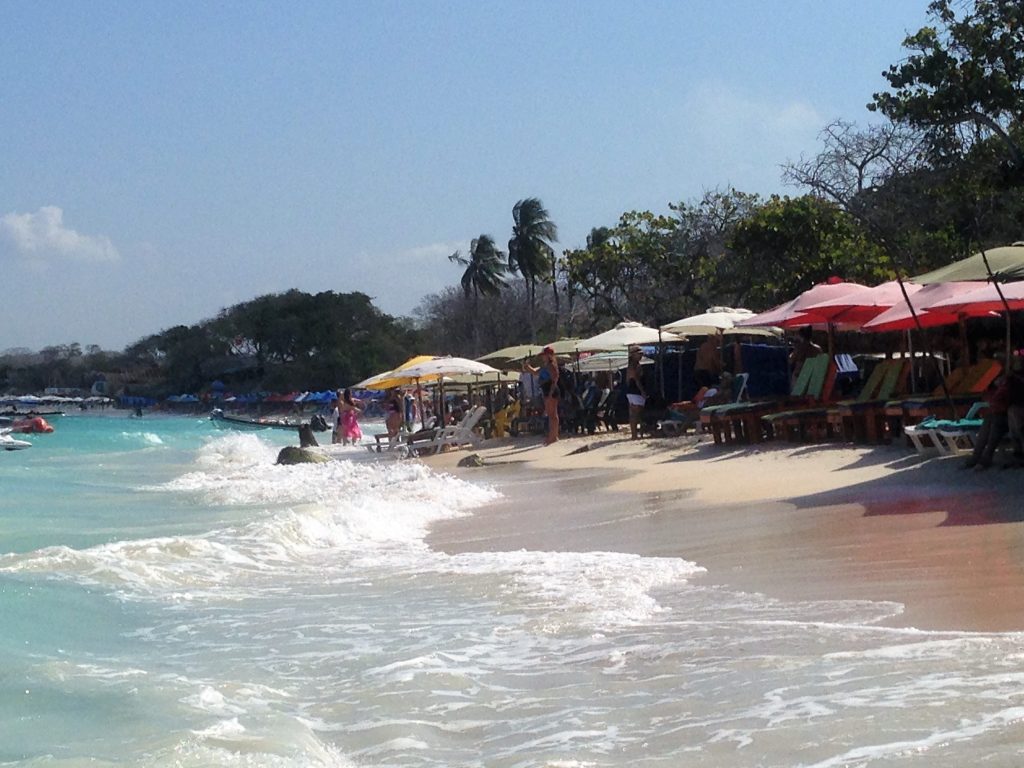
Almost the entire beach at Playa Blanca was covered by umbrellas and chairs – all to be rented for very negotiable prices
But the wait for Tramp was agonising and we were getting restless for a new scene. So we came up with a short term plan to use a few days exploring new places while Tramp slowly made his way to Colombia.
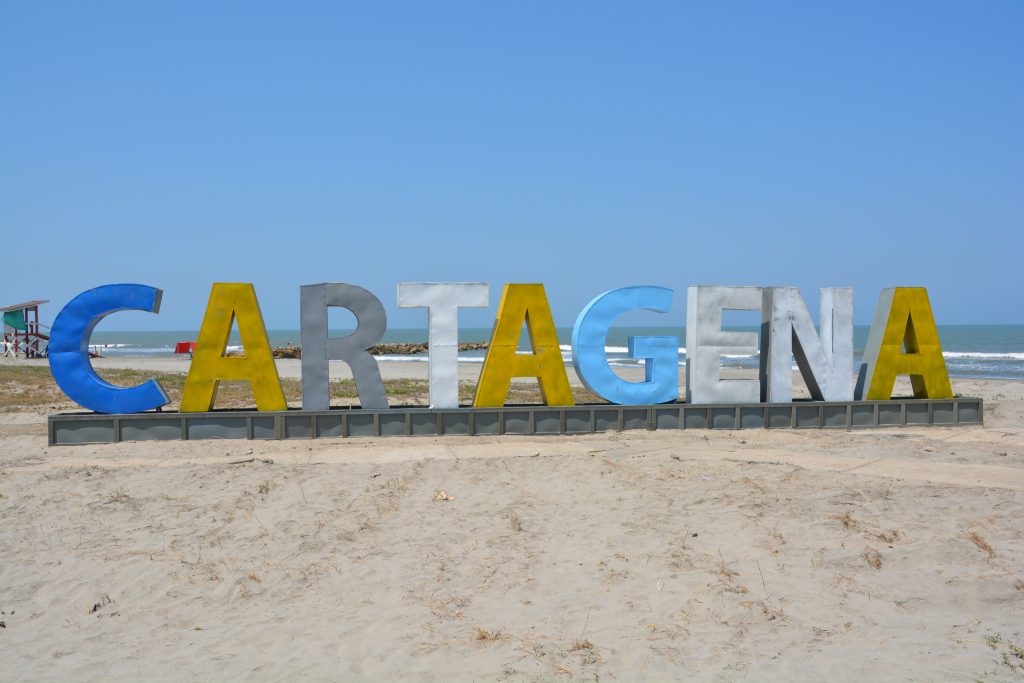
Cartagena followed the trend – or maybe started it – of having their letters prominently displayed, in their case on one of their deep endless beaches
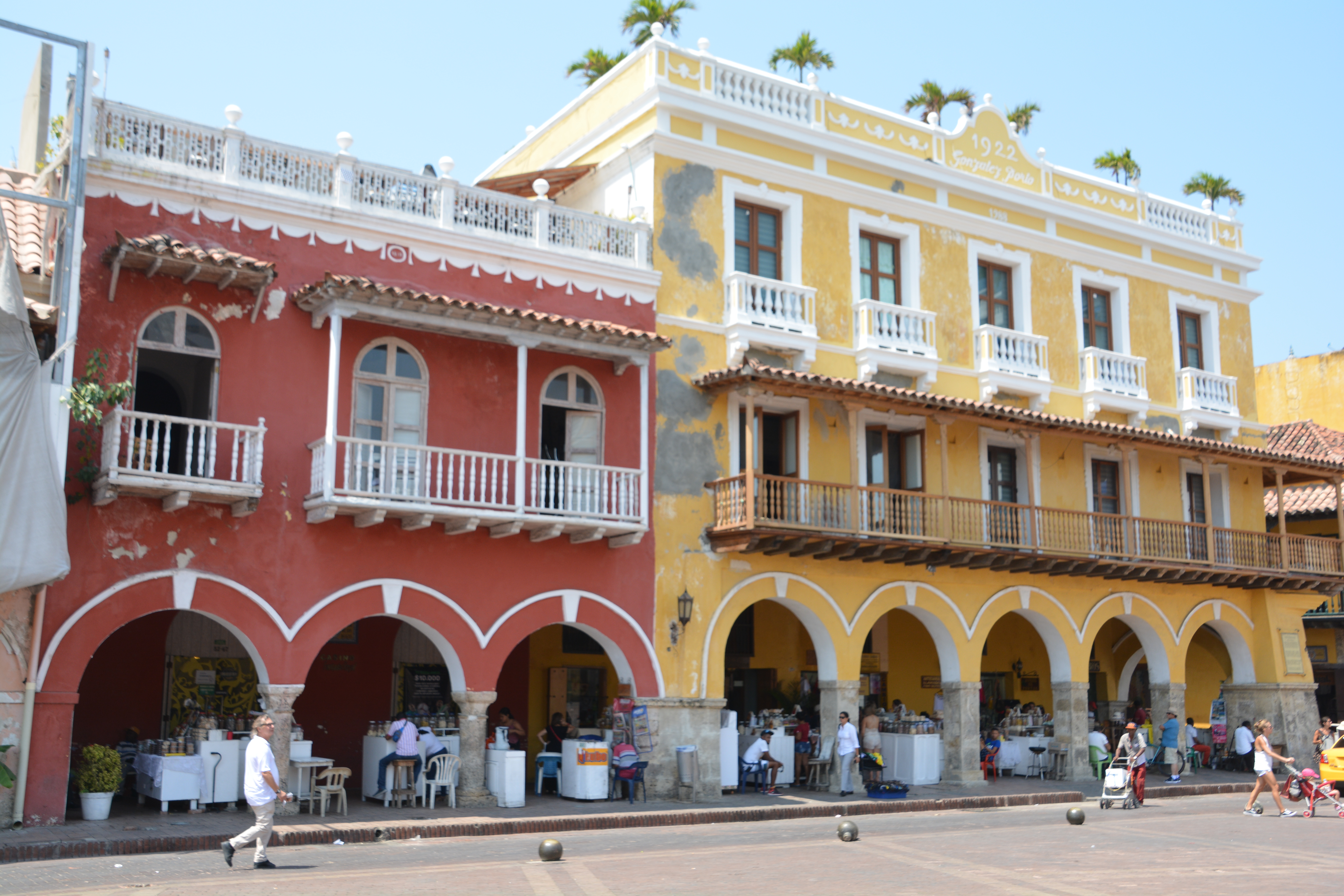



















Comments
Cartagena without Tramp — No Comments
HTML tags allowed in your comment: <a href="" title=""> <abbr title=""> <acronym title=""> <b> <blockquote cite=""> <cite> <code> <del datetime=""> <em> <i> <q cite=""> <s> <strike> <strong>